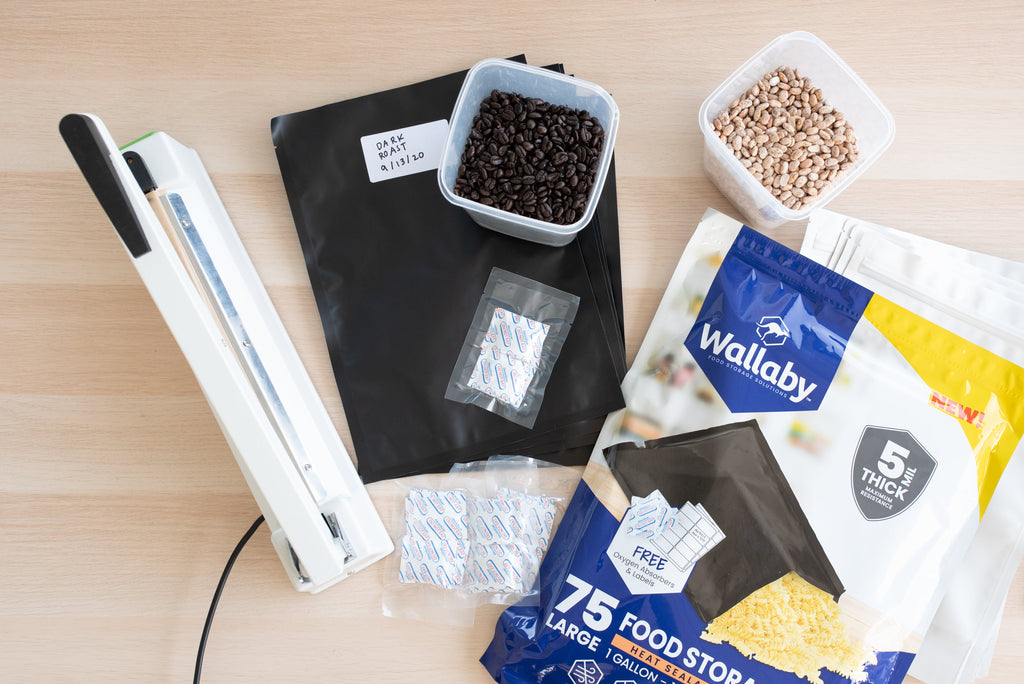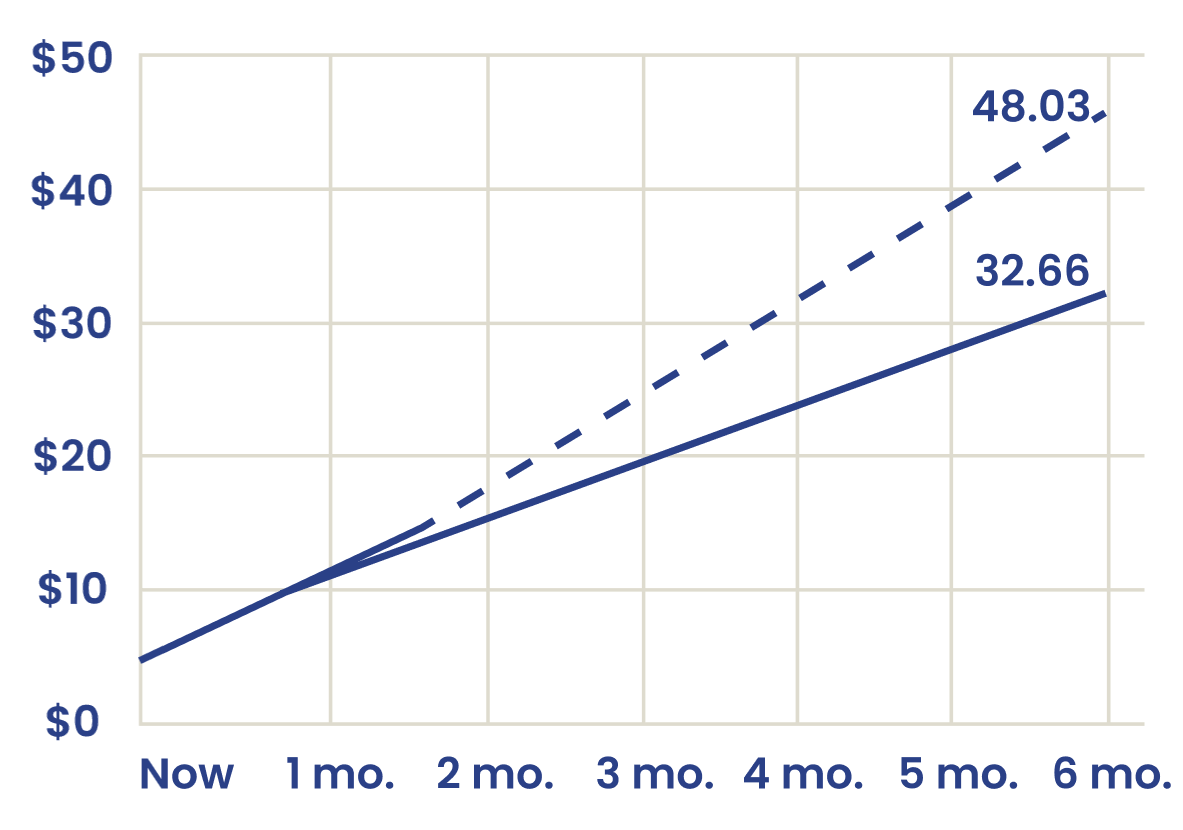Food storage options help you to be more economical and keep your food fresher, for longer. With the pandemic and all of the supply chain issues that came along with it, many people decided to start “prepping” in a way they hadn’t before. Creative storage solutions can go a long way in preserving food and other dry goods. Foil pouches and Mylar bags are a wise investment for anyone hoping to do more long term storage.
In this post you’ll learn more about packaging dry foods in Mylar bags for long term storage, including:
- What is a foil pouch or Mylar bag?
- What are the advantages to storing food in Mylar bags?
- Are there disadvantages to storing food in Mylar bags?
- What foods are best for Mylar bag storage?
- How to select the right Mylar bag for food storage
- 5 simple steps for packaging food in Mylar bags for long term storage
What is a foil pouch or Mylar bag?
Mylar pouches are essentially bags made from several layers of laminated food-grade plastic and aluminum. Food doesn’t react with the aluminum because it is separated by a special BPA-free lining. They provide a strong light, moisture, and oxygen barrier, which protects the items inside the bag. High quality pouches will do a better job of storing food products.
Are there advantages to storing food in Mylar bags?
Mylar bags do a great job of protecting against air, moisture, insects, and other elements. When food is sealed inside with oxygen absorbers, the oxygen is nearly all removed. This creates a nitrogen environment inside where bacteria and mold are prevented from forming. Another advantage of Mylar bags is that they can suit your unique needs. They come in a variety of sizes, from small enough to store garden seeds to large enough to line a 5-gallon bucket. Plus, some Wallaby bags offer a resealable zipper, so that you don’t need to invest in any separate tools, and you can use them again and again.
Are there any disadvantages?
Mylar bags are not rodent proof, so extra steps need to be taken for optimal storage. In addition, depending what you put into the bags, they might not stack well. You might consider using a large Mylar bag inside a 5-gallon bucket for maximum storage potential.
Which foods are best for Mylar bag storage?
When it comes to food storage, you should only package shelf-stable foods that are low in oil and moisture content. The best options have a moisture content of 10% or less. Dry goods like white rice, wheat, flour, beans, sugar, and oats are all good choices for storing in Mylar bags. You could also try freeze dried foods.
It’s important to note that whole foods store better than ground versions (such as whole grains or whole corn vs. cornmeal). Also, you can package dehydrated fruits and vegetables in Mylar bags, but it’s essential that the foods are completely dry and that you use an oxygen absorber. It’s typically not worth the risk for those categories of foods.
Selecting the right Mylar bag for food storage
There are several Mylar bag and pouch options available. If you really want to protect your food, it’s important to invest in the right, high quality Mylar bag products.
There are several thicknesses, and the higher the MIL rating, the thicker and stronger the bag is. The 5 mil and greater are best for packaging dry goods for long term storage.
- One gallon pouches - these are a great size for packaging freeze dried or dry foods for a family
- Half-gallon or quart pouches - some foods are better off stored in smaller quantities, and these bags are appropriate
- 5-gallon bag to use in a large bucket - Mylar creates a great oxygen barrier so it can be a very effective storage strategy to place one inside a larger bucket that is rodent proof
For the longest storage life possible, we recommend placing a Mylar bag inside a bucket or container that is also rodent proof and storing in a cool, dark, dry place.
Packaging dry foods in Mylar bags for long term storage
Wallaby offers several bundle options that include everything you need to fill, store, and label dry goods. Here are the steps you can take to properly use Mylar bags for maintaining a long-term food supply and safely storing dry goods.
- Label the Mylar bags. It makes sense to label each bag with what’s inside as well as the date. That part might be common sense, but many people attempt to do this after they fill it, which can be difficult. Label before you place anything into the pouch.
- Fill the Mylar bags with dry food. We suggest using a partner system for this. Have one person hold the bag open and the other pour the food into it. Leave a little room at the top so you can more easily handle the zipper or heat sealed top.
- Add an oxygen absorber on top of the food, typically 400cc per gallon of storage. Once the bags are filled, place an oxygen absorber into each bag and then quickly seal. Oxygen absorbers are included with Wallaby products, but if you choose other products you will need to purchase these components.
- Seal the Mylar pouches shut. Wallaby offers convenient and easy-to-use zipper closures, but other products require the use of a vacuum seal or a heat seal. You can create a heat seal with an iron or even a hair straightener.
- Store Mylar bags in a rodent-proof container. Remember that Mylar pouches are not 100% rodent-proof. If you want to really ensure your food is safe for as long as possible, place your filled bags into containers that are safe from rodents. You can use gallon buckets or large plastic totes. One tip: once the oxygen absorbers have taken effect, the bags will become more rigid. It typically takes about 4-12 hours for that process to complete and then bags will be a bit more difficult to manipulate. It’s best to get bags into your larger container before that happens, or leave them out resting flat, so they shrink flat versus standing.
Mylar bags provide an effective light, moisture, and oxygen barrier, which makes them ideal for long-term food storage. They can also be used for other purposes such as protecting metal tools from rust or protecting critical documents from water damage. Wallaby Goods bags are incredibly versatile and can extend the shelf life of food for up to 30 years.
Shop our site to discover why thousands of happy customers love Wallaby.

SHARE:





